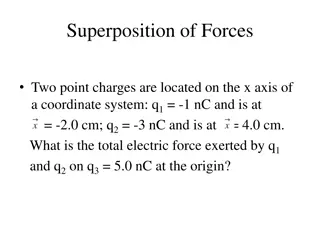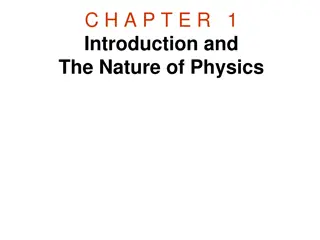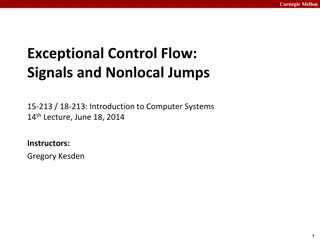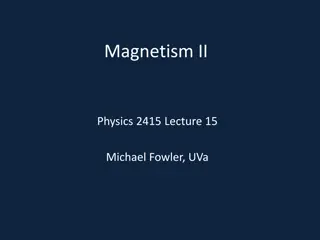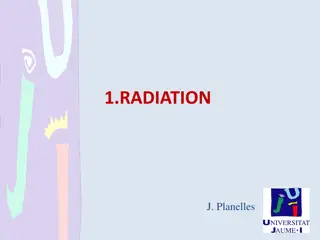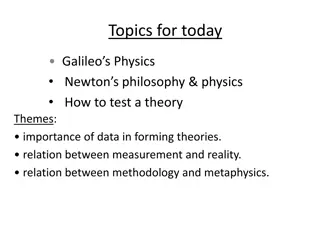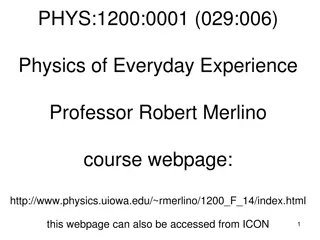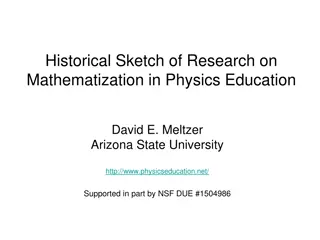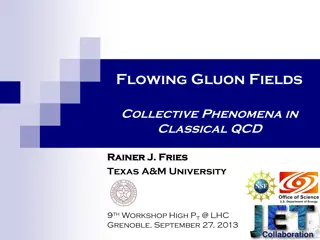Understanding E and B Fields in Physics 213
Explore concepts such as light polarization angles, resonance frequency of LRC circuits, Lorentz Force Law, Gauss Law, Faraday's Law, and Ampere-Maxwell Law in Physics 213. Delve into the interplay between electric and magnetic fields, and their effects on charged particles such as electrons and protons. Dive deep into the complex relationship between E and B fields through practical examples and theoretical explanations.
Uploaded on Sep 17, 2024 | 0 Views
Download Presentation

Please find below an Image/Link to download the presentation.
The content on the website is provided AS IS for your information and personal use only. It may not be sold, licensed, or shared on other websites without obtaining consent from the author. Download presentation by click this link. If you encounter any issues during the download, it is possible that the publisher has removed the file from their server.
E N D
Presentation Transcript
Things left to do in Ph 213: - Understand light and E, B and S. - Understand the concept of light polarization angles - Find the resonance frequency of LRC circuits. Next week: Monday: Chapter 34 Tuesday: Concept Test Wednesday: Review Part 1 Wed/Thurs Lab: Complete Finals Friday: Review Part 2 Saturday: Study Jam
Chapter 35 In this chapter, we re going to try to pull together everything we know about E and B fields. B E Let s have a proton moving through space experiencing both an E-field and a B-field. v0 + F = qE + qvxB Lorentz Force Law
35.3 An electron travels with v = 5106 m/s in a space where E = <2.0 105 ,-2.0 105 >V/m and B = -0.10k-hat T. What is the net force on the electron?
To B or not to B? It all depends upon your frame of reference. Bill is creating a magnetic field stationary to himself. Sharon is running with a charge stationary to herself.
What weve done so far: q Relates net electric flux to net charge enclosed = E d A enc Gauss Law o Relates net magnetic flux to net magnetic charge enclosed Gauss Law = 0 B d A dt d dt d = A changing magnetic flux induces an electric field = E V s d emf B B Faraday s Law d s d = + B I E Ampere-Maxwell Law A changing electric flux induces a magnetic field (as does an electric current) o o o enc dt
Lets try messing around a bit with Faradays Law dx y + dt d E d E = E s d B E x h + B Let s calculate the left had side of this equation. B d B z = + = ( ) E s d E dE h Eh hdE
Lets try messing around a bit with Faradays Law dx y + dt d E d E = E s d B E Now, let s work on the right side of the equation. x h + B B d B z d B= Bhdx dB B= hdx dt dt
dt d = E s d B d dB = E s d hdE B= hdx dt dt dB = hdE hdx dt B E dE dB = = x t dx dt
So, Faradays Law gives us this: E B = x t Doing a similar thing to Ampere s Law gives us: B E = o o x t
E B B E = = o o x t x t Take the derivative w.r.t. x on this Then substitute this in 2 E B B E = = = ( ) o 2 x x t t x t t o 2 2 E E = ( ) o 2 2 x t o Ah-ha! It s a wave Equation!
2 2 E E = ( ) o o 2 2 x t Ah-ha! It s a wave Equation! Thus you know: E = Eocos(kx- t) You also know that the speed of the wave is: 1 1 = = v o 12 9 . 8 7 4 10 10 o All in mks units
2 2 E E = ( ) o o 2 2 x t You can do the same thing for the B-field and find out the the same thing happens. Thus you know: E = Eocos(kx- t) B = Bocos(kx- t) You also know that the speed of the wave is: 1 1 = = v o 12 9 . 8 7 4 10 10 o c = 3 108 m/s
Lets try to visualize this: http://phet.colorado.edu
Thus you know: E = Eocos(kx- t) B = Bocos(kx- t) How are the amplitude of E and B related? Eo=cBo
Maxwell thus showed us that: E-fields and B-fields behave like self-perpetuating waves. These electromagnetic waves can travel through empty space. 1 The speed of EM waves is = c 1 o o = media c Corollary: E and B fields are perpendicular to each other and mutually perpendicular to the direction of travel. E = cB (in empty space) Like all waves, EM waves obey superposition rules.
A story problem to solve: 1) T.V. Signals from the Earth have now reached the nearest 400 suns. Survivor first aired 4 years ago. Has the Survivor show reached Alpha-Centauri yet? The Centauri system is 4 1013 km away. 2) The E-field at a TV broadcasting dish is measured to be 250V/m. Assuming a perfectly collimated beam, what would the B-field be at Alpha-Centauri? 3) The broadcast is sent at a frequency of 4 109Hz. What is the wavelength of the TV wave? 4) Let s say that a space probe at Alpha-Centauri is moving away from the Earth at speed of 1 108m/s. What frequency would Survivor be found on on TV on the Centauri probe?
Polarization http://micro.magnet.fsu.edu/primer/java/polarizedlight/emwave/
Polarization fromBook The plane in which the E-field is waving is called the Plane of Polarization We can test the polarization of a wave by using a Polarizer and Malus Law. Itransmitted = Iocos2








